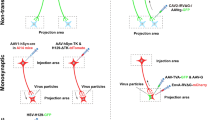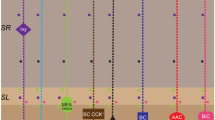Abstract
Induced pluripotent stem (iPS) cells offer the exciting opportunity for modeling neurological disorders in vitro in the context of a human genetic background. While significant progress has been made in advancing the use of iPS cell-based disease models, there remains an unmet need to characterize the electrophysiological profile of individual neurons with sufficient throughput to enable statistically robust assessment of disease phenotypes and pharmacological modulation. Here, we describe the Optopatch platform technology that utilizes optogenetics to both stimulate and record action potentials (APs) from human iPS cell-derived excitatory neurons with similar information content to manual patch clamp electrophysiology, but with ~ 3 orders of magnitude greater throughput. Cortical excitatory neurons were produced using the NGN2 transcriptional programming approach and cultured in the presence of rodent glial cells. Characterization of the neuronal preparations using immunocytochemistry and qRT-PCR assays reveals an enrichment of neuronal and glutamatergic markers as well as select ion channels. We demonstrate the scale of our intrinsic cellular excitability assay using pharmacological assessment with select ion channel modulators quinidine and retigabine, by measuring changes in both spike timing and waveform properties. The Optopatch platform in human iPS cell-derived cortical excitatory neurons has the potential for detailed phenotype and pharmacology evaluation, which can serve as the basis of cellular disease model exploration for drug discovery and phenotypic screening efforts.





Similar content being viewed by others
References
Gribkoff VK, Kaczmarek LK (2017) The need for new approaches in CNS drug discovery: why drugs have failed, and what can be done to improve outcomes. Neuropharmacology 120:11–19. https://doi.org/10.1016/j.neuropharm.2016.03.021
Forray C, Buller R (2017) Challenges and opportunities for the development of new antipsychotic drugs. Biochem Pharmacol 143:10–24. https://doi.org/10.1016/j.bcp.2017.05.009
Keshavan MS, Lawler AN, Nasrallah HA, Tandon R (2017) New drug developments in psychosis: challenges, opportunities and strategies. Prog Neurobiol 152:3–20. https://doi.org/10.1016/j.pneurobio.2016.07.004
Pankevich DE, Altevogt BM, Dunlop J et al (2014) Improving and accelerating drug development for nervous system disorders. Neuron 84:546–553. https://doi.org/10.1016/j.neuron.2014.10.007
Choi DW, Armitage R, Brady LS et al (2013) Medicines for the mind: policy-based ‘” Pull”’ incentives for creating breakthrough CNS drugs. Neuron 84:554–563. https://doi.org/10.1016/j.neuron.2014.10.027
Butlen-ducuing F, Pétavy F, Guizzaro L et al (2016) Challenges in drug development for central nervous system disorders: a European Medicines Agency perspective. Nat Rev Drug Discov 15:813–814. https://doi.org/10.1038/nrd.2016.237
Millan MJ, Goodwin GM, Meyer-lindenberg A, Ove S (2015) Learning from the past and looking to the future: emerging perspectives for improving the treatment of psychiatric disorders. Eur Neuropsychopharmacol. https://doi.org/10.1016/j.euroneuro.2015.01.016
Kaiser T, Feng G (2015) Modeling psychiatric disorders for developing effective treatments. Nat Med 21:979–988. https://doi.org/10.1038/nm.3935
Forum on Neuroscience and Nervous System Disorders, Board on Health Sciences Policy, Institute of Medicine (2014) Improving and accelerating therapeutic development for nervous system disorders: workshop summary. National Academies Press, Washington, DC. Available from: https://www.ncbi.nlm.nih.gov/books/NBK169736/
Eisen JA, Ganley E, Maccallum CJ (2014) Open science and reporting animal studies: who’ s accountable ? PLoS Biol 12:1–3. https://doi.org/10.1371/journal
Holmes GL, Noebels JL (2016) The epilepsy spectrum: targeting future research challenges. Cold Spring Harb Perspect Med. https://doi.org/10.1101/cshperspect.a028043
Insel T (2014) The NIMH research domain criteria (RDoC) project: precision medicine for psychiatry. Am J Psychiatry 171(4):395–397
Papassotiropoulos A, Quervain DJ, De (2015) Failed drug discovery in psychiatry: time for human genome-guided solutions. Trends Cogn Sci 19:183–187. https://doi.org/10.1016/j.tics.2015.02.002
Matsumoto M, Walton NM, Yamada H et al (2017) The impact of genetics on future drug discovery in schizophrenia. Expert Opin Drug Discov 12:673–686. https://doi.org/10.1080/17460441.2017.1324419
Breen G, Li Q, Roth BL et al (2016) Translating genome-wide association findings into new therapeutics for psychiatry. Nat Nuerosci 19(11):1392
PsychiatricGenomicsConsortium (2015) Psychiatric genome-wide association study analyses implicate neuronal, immune and histone pathways. Nat Neurosci. https://doi.org/10.1038/nn.3922
Chaste P, Klei L, Sanders SJ et al (2015) A genome-wide association study of autism using the Simons simplex collection: does reducing phenotypic heterogeneity in autism increase genetic homogeneity? Biol Psychiatry 77:775–784. https://doi.org/10.1016/j.biopsych.2014.09.017
Liu Y, Lopez-Santiago LF, Yuan Y et al (2013) Dravet syndrome patient-derived neurons suggest a novel epilepsy mechanism. Ann Neurol 74:128–139. https://doi.org/10.1002/ana.23897
Mertens J, Wang Q-W, Kim Y et al (2015) Differential responses to lithium in hyperexcitable neurons from patients with bipolar disorder. Nature 527:95–99. https://doi.org/10.1038/nature15526
Wainger BJ, Kiskinis E, Mellin C et al (2014) Intrinsic membrane hyperexcitability of amyotrophic lateral sclerosis patient-derived motor neurons. Cell Rep 7:1–11. https://doi.org/10.1016/j.celrep.2014.03.019
Mertens J, Wang Q-W, Kim Y et al (2015) Differential responses to lithium in hyperexcitable neurons from patients with bipolar disorder. Nature 527:95
Habela CW, Song H, Ming G (2016) Modeling synaptogenesis in schizophrenia and autism using human iPSC derived neurons. Mol Cell Neurosci 73:52–62. https://doi.org/10.1016/j.mcn.2015.12.002
Watmuff B, Berkovitch SS, Huang JH et al (2016) Disease signatures for schizophrenia and bipolar disorder using patient-derived induced pluripotent stem cells. Mol Cell Neurosci 73:96–103. https://doi.org/10.1016/j.mcn.2016.01.003
Li HL, Gee P, Ishida K, Hotta A (2016) Efficient genomic correction methods in human iPS cells using CRISPR-Cas9 system. Methods 101:27–35
Paquet D, Kwart D, Chen A et al (2016) Efficient introduction of specific homozygous and heterozygous mutations using CRISPR/Cas9. Nature 533:125–129. https://doi.org/10.1038/nature17664
Avior Y, Sagi I, Benvenisty N (2016) Pluripotent stem cells in disease modelling and drug discovery. Nat Rev Mol Cell Biol 17:170–182. https://doi.org/10.1038/nrm.2015.27
Swinney DC, Anthony J (2011) How were new medicines discovered? Nat Rev Drug Discov 10:507–519. https://doi.org/10.1038/nrd3480
Zheng W, Thorne N, McKew JC (2013) Phenotypic screens as a renewed approach for drug discovery. Drug Discov Today 18:1067–1073. https://doi.org/10.1016/j.drudis.2013.07.001
Eder J, Sedrani R, Wiesmann C (2014) The discovery of first-in-class drugs: origins and evolution. Nat Rev Drug Discov 13:577–587. https://doi.org/10.1038/nrd4336
Hempel CM, Werley CA, Dempsey GT, Gerber DJ (2017) Targeting neuronal function for CNS drug discovery. Drug Discov Today Technol 23:17–25. https://doi.org/10.1016/j.ddtec.2017.03.005
Haggarty SJ, Silva MC, Cross A et al (2016) Advancing drug discovery for neuropsychiatric disorders using patient-speci fi c stem cell models. Mol Cell Neurosci 73:104–115. https://doi.org/10.1016/j.mcn.2016.01.011
Boulting GL, Kiskinis E, Croft GF et al (2011) A functionally characterized test set of human induced pluripotent stem cells. Nat Biotechnol 29:279–286. https://doi.org/10.1038/nbt.1783.A
Zhang Y, Pak C, Han Y et al (2013) Rapid single-step induction of functional neurons from human pluripotent stem cells. Neuron 78:785–798
Di Giorgio FP, Boulting GL, Bobrowicz S, Eggan KC (2008) Human embryonic stem cell-derived motor neurons are sensitive to the toxic effect of glial cells carrying an ALS-causing mutation. Cell Stem Cell 3:637–648. https://doi.org/10.1016/j.stem.2008.09.017
Werley CA, Brookings T, Upadhyay H et al (2017) All-optical electrophysiology for disease modeling and pharmacological characterization of neurons. Curr Protoc Pharmacol. https://doi.org/10.1002/cpph.25
Hochbaum DR, Zhao Y, Farhi SL et al (2014) All-optical electrophysiology in mammalian neurons using engineered microbial rhodopsins. Nat Methods 11:825–833. https://doi.org/10.1038/nmeth.3000
Adam Y, Kim JJ, Lou S et al (2018) All-optical electrophysiology reveals brain-state dependent changes in hippocampal subthreshold dynamics and excitability. bioRxiv. https://doi.org/10.1101/281618
Werley CA, Chien M-P, Cohen AE (2017) An ultrawidefield microscope for high-speed fluorescence imaging and targeted optogenetic stimulation. Biomed Opt Express 8:5794. https://doi.org/10.1364/BOE.8.005794
Pak CH, Danko T, Zhang Y et al (2015) Human neuropsychiatric disease modeling using conditional deletion reveals synaptic transmission defects caused by heterozygous mutations in NRXN1. Cell Stem Cell 17:316–328. https://doi.org/10.1016/j.stem.2015.07.017
Maroof AM, Keros S, Tyson J et al (2013) Directed differentiation and functional maturation of cortical interneurons from human embryonic stem cells. Cell Stem Cell 12:559–572. https://doi.org/10.1016/j.stem.2013.04.008
Ducouret P (1976) The effect of quinidine on membrane electrical activity in frog auricular fibres studied by current and voltage clamp. Br J Pharmacol 57:163–184. https://doi.org/10.1111/j.1476-5381.1976.tb07465.x
Alexander SPH, Striessnig J, Kelly E et al (2017) The concise guide to pharmacology 2017/18: voltage-gated ion channels. Br J Pharmacol 174:S160–S194. https://doi.org/10.1111/bph.13884
Roberts GKM and E (2014) Structure activity relationships of novel antiepileptic drugs. Curr Med Chem 21:722–754
Sandoe J, Eggan K (2013) Opportunities and challenges of pluripotent stem cell neurodegenerative disease models. Nat Neurosci 16:780–789. https://doi.org/10.1038/nn.3425
Acknowledgements
L.A.W., V.J., J.F., C.A.W., O.M. and G.T.D. are employees of Q-State Biosciences. J.G. and C.H.D. are employees of Takeda Pharmaceuticals. We thank Dr. Steven Ryan (Q-State Biosciences) for assistance with revisions of the manuscript.
Author information
Authors and Affiliations
Corresponding authors
Additional information
Special issue: In honor of Graham Collingridge.
Rights and permissions
About this article
Cite this article
Williams, L.A., Joshi, V., Murphy, M. et al. Scalable Measurements of Intrinsic Excitability in Human iPS Cell-Derived Excitatory Neurons Using All-Optical Electrophysiology. Neurochem Res 44, 714–725 (2019). https://doi.org/10.1007/s11064-018-2694-5
Received:
Revised:
Accepted:
Published:
Issue Date:
DOI: https://doi.org/10.1007/s11064-018-2694-5




